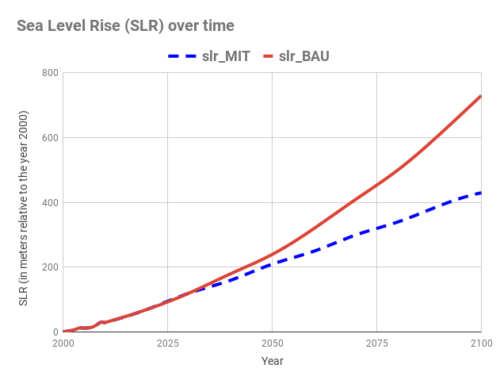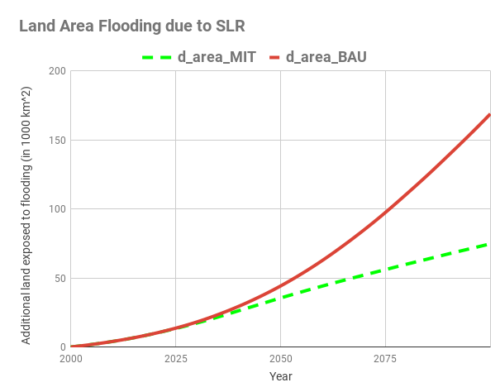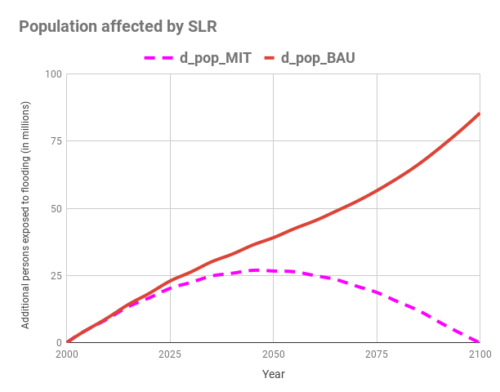Composers who tell this story will help audiences understand how sea level rise from climate change reduces available land area in which humans can live and negatively affects the population of those areas. The goal of this story is to inspire the audience to act—to take action to prevent catastrophic flooding and the mass displacement of communities. Telling this story will help motivate the audience to demand a more equitable and livable future.
Key points:
- It is now inevitable that sea levels will continue to rise over the rest of the 21st century and the next several hundred years after that.
- The silver lining is that, over the long-term, we can reduce how much the seas will rise IF we act now and curb human activities that are causing climate change.
- This story provides a good example of the idea of “lag times”, which is a key to understanding why action on climate change is urgent.
Reminder: the core of our collaboration is your interaction with our science team; this page serves only to provide a reference to the science outside of our interactions.
If you want to learn more…
Sea Level Rise and Climate Change
The data:
- sea level rise
- the area in the 1 in 100 year floodplain
- the population in the 1 in 100 year floodplain area
The response of the oceans and ice to global warming is a slow process (decades to centuries), so it is now inevitable that sea levels will continue to rise over the rest of the 21st century and the next several hundred years after that. Addressing the human causes of climate change is necessary for several reasons, but reducing emissions of greenhouse gases will only reduce—and not stop—the rate of sea level rise for the next few centuries.
The silver lining is that, over the long-term, we can reduce how much the seas will rise IF we act now and curb human activities that are causing climate change. Under a “business as usual” scenario, by 2100 the area of land exposed to flooding is estimated to be 35% larger than the floodplain area measured in 2000. But, early and effective action to reduce human impacts on climate can limit the floodplain area increase to 15% compared to 2000 levels. This difference becomes even more dramatic as we go further in time: a “business as usual” scenario will triple the floodplain area in 2300, while mitigation will limit the floodplain increase to just 30%. To put that into perspective, roughly an area the size of California, Oregon, Washington, Nevada, Idaho and Arizona combined will be impacted by sea level rise in 2300 if we don’t act now.
This story provides a good example of the idea of “lag times”, which is key to understanding why action on climate change is urgent. Many might suppose that we can just “turn off” climate change at some more convenient date in the future by cutting our emissions and planting trees when it suits us. But this story illustrates why that is not the case: because oceans and ice respond slowly to global warming, we have yet to witness the disruption that our current level of climate change-affecting behavior will wreak upon our livelihoods. Therefore, telling this story through ClimateMusic will help people understand our need to act now—not only are we behind the ball, but that we are on track to dramatically reduce the livable land area on our planet, which will result in mass migrations and likely political and violent conflict
Two possible ways to think about this story musically could be:
- Referencing the data to compose a piece about sea-level rise
- Referencing the data to compose a piece that plays with the idea of lag-times (using data from the story) in a way that underscores why action is urgent
Note: In the graphs, “BAU”= the “business as usual” scenario for the future; “MIT”=the “mitigation” scenario for the future in which we act quickly now to cut our carbon emissions.



Audio References (sonifications).
These sonification files (affected land area) by composer Mary (Molly) Monahan are provided to give you an intuitive way to understand the data. Three diverse versions are included here, reflecting a wide range of creative possibilities. Note: A gong sounds when the data reaches the present day.
Version 1: Business as Usual
Version 1: We Act Now
Version 2: Business As Usual
Version 2: We Act Now
Version 3: Business As Usual
Version 3: We Act Now
Other Resources
Toggle Content